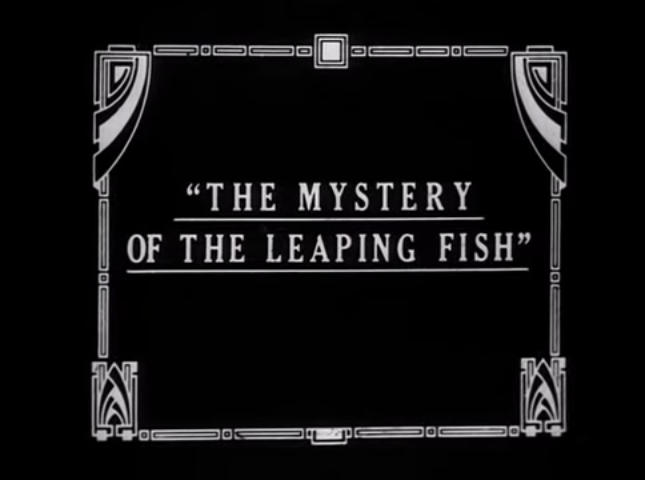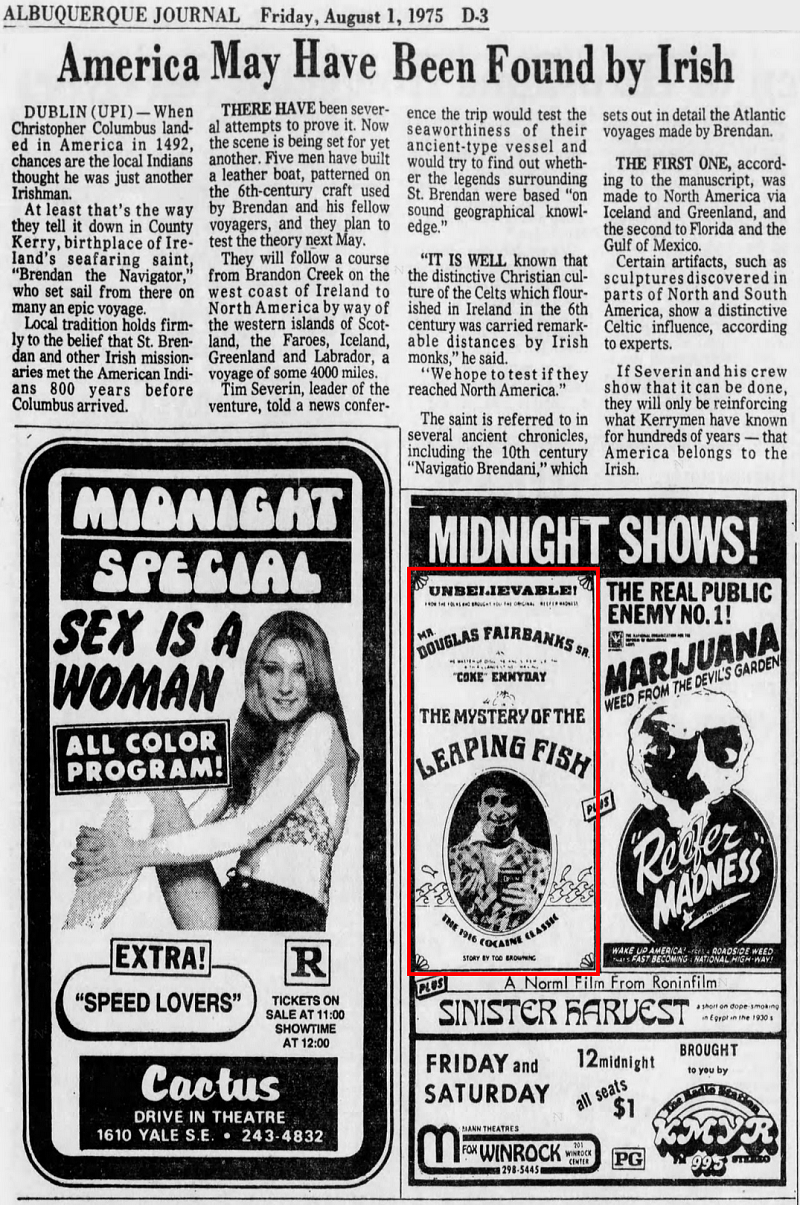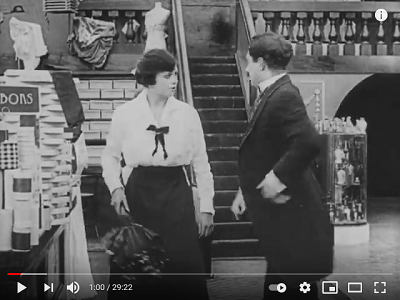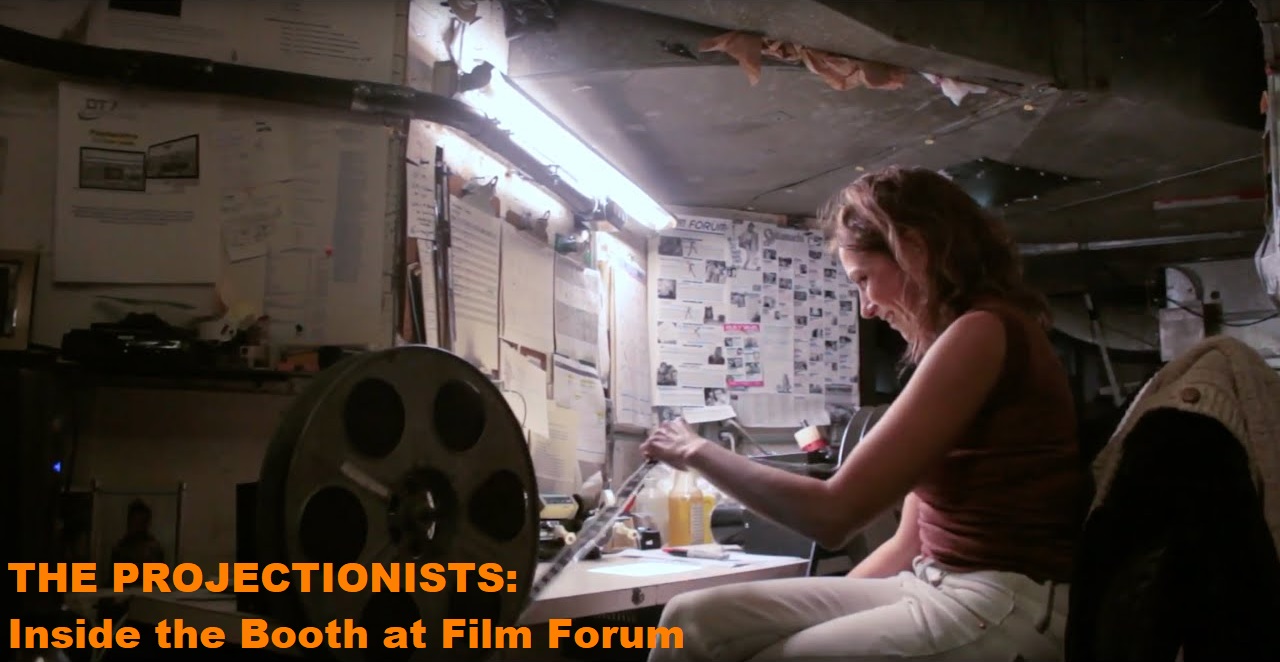Chapter 58
The Unexpected Revelation
The Unexpected Revelation
Admittedly, in spending maybe 20 or so hours sifting through movie ads in 1960’s and 1970’s Albuquerque newspapers, I am a bit stunned.
I looked at the movie ads every day back in the 1970’s, but I comprehended almost nothing.
The films that I discovered at The Guild and at Donald Pancho’s and at UNM were, I thought, films that did not play elsewhere in town.
How wrong I was!
I was startled to discover that
The Devils
had opened at the Sunshine,
that Siddhartha had played
at the Eastdale,
that Long Ago, Tomorrow
(original British title: The Raging Moon)
had opened at the Cinema East.
My breath was taken away to discover that Humphrey Bogart
and Charlie Chaplin
and various other old-time items rather frequently played
at first-run
and second-run Commonwealth cinemas.
Even The Lavender Hill Mob and
The Ladykillers
popped up again at the Lobo in June 1973!!
Of course, they were all cropped to 1:1.85 or 1:2.00, but I never even noticed the advertisements!
Scenes from a Marriage played
at the newly opened M-Plaza ,
surely cropped to incomprehensibility.
My jaw dropped to discover that one of my favorite movies ever,
O Lucky Man!,
had its Albuquerque première at the Fox Winrock!!!!!
It played only a single week.
Why do I doubt that it sold more than three tickets?
Why do I suspect that the purchasers of those three tickets all demanded their money back?
The most dumbfounding discovery of all, though, is that The Mystery of the Leaping Fish
played at the Fox Winrock!!!!!!!!!!!
A 35mm silent print, without musical accompaniment, cropped to senselessness, tremendously overspeeded, but it played!!!!!
So, I need to rethink what I thought I knew about the movie business.
I know that you entirely disbelieve my claim that The Mystery of the Leaping Fish
ever played at the Fox Winrock. Fine.
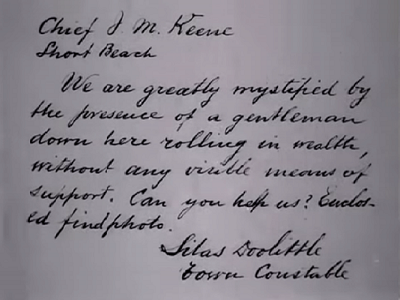 The Mystery of the Leaping Fish Proper presentation: full-frame Silent 1:1.33 projector aperture .6796"×.90625" |
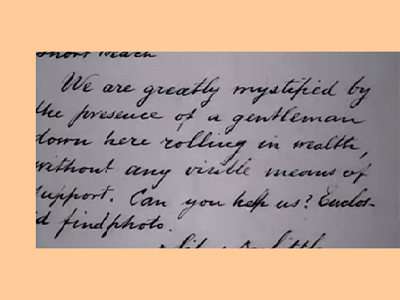 The Mystery of the Leaping Fish As cropped at modern American cinemas: US widescreen 1:1.85 projector aperture .446"×.825" |
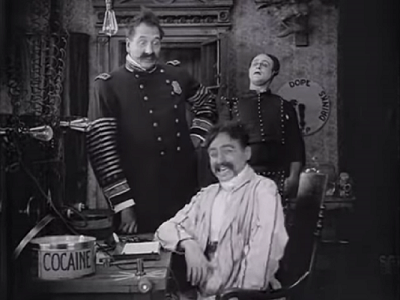 The Mystery of the Leaping Fish Proper presentation: full-frame Silent 1:1.33 projector aperture .6796"×.90625" |
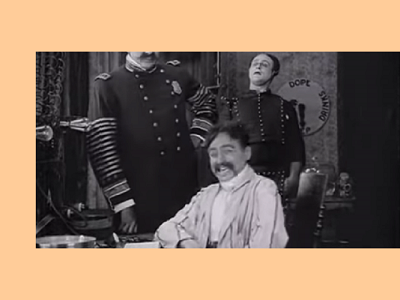 The Mystery of the Leaping Fish As cropped at modern American cinemas: US widescreen 1:1.85 projector aperture .446"×.825" |
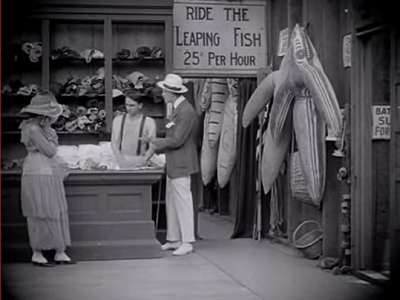 The Mystery of the Leaping Fish Proper presentation: full-frame Silent 1:1.33 projector aperture .6796"×.90625" |
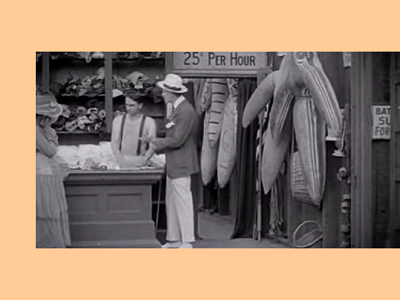 The Mystery of the Leaping Fish As cropped at modern American cinemas: US widescreen 1:1.85 projector aperture .446"×.825" |
For the sake of completeness:
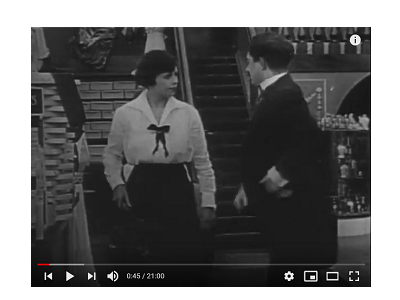 https://youtu.be/coOpysyocak 21 minutes, about 24fps The Floorwalker, as it has been seen since 1932. | |
|
Watch them both.
On the left is a video edition kinda sorta based on the Amadee J. Van Beuren reissue of 1932, which had been the version we all grew up with.
On the right is the recent restoration by the Cineteca Bologna and Lobster Films.
Can you see the differences?
Can you explain the differences?
The video edition on the left is a compromise, which lopped off all four sides.
The original Van Beuren reissue of 1932 lopped off only the left side, to make way for the soundtrack.
Cinemas then lopped off the top and bottom, because the managers confiscated the older apertures and lenses.
| |
So, as I now discover, the specialty movies, the foreign movies, the off-beat movies
that populated the screens at The Guild and at Donald Pancho’s
were not booked solely at specialty houses.
Not at all.
They were merely second-run and repertory, left-overs that had finished their first runs.
There are numerous movies associated indelibly in my mind exclusively with Donald Pancho’s and The Guild,
and yet they were in fact commercial hand-me-downs.
Harold and Maude and
Walkabout had opened at the Fox Winrock.
Performance and
if.... had opened at the Lobo.
Marat/Sade had opened at the Hiland.
Women in Love
had opened at Loew’s in the Mall.
The Boy Friend had opened at the Sunshine without any fanfare.
The Ruling Class
had opened at Los Altos Twin Screen 1.
The list goes on.
As I see more and more examples of this, it occurs to me that Donald Pancho’s and The Guild in fact ran hand-me-downs almost exclusively.
Commercial cinemas generally played a movie for a week or two or three, and that was the end of that.
The movie was then forgotten.
Movies were throw-away items made for a quick return.
Audiences would glance at the ads and recognize the patterns.
This movie is a cop story.
This movie is a puppy-love story.
This movie is an action story.
This movie is an unfunny comedy.
This movie is a war story.
This movie is blaxploitation story.
This movie is a children’s story.
This movie is a gangster story.
Depending upon which particular pre-fab category they were in the mood for that night, that’s the movie they would choose.
Why? Just to kill two hours. That’s all.
It had been a tedious week at the office, and now it was time to sit back and become unconscious for a little while before going back home to do chores.
That’s what movies were, and that’s what they still are, and that’s what they have always been.
Movies played briefly, they got their net, if there was any, and then they were done.
Once VHS and βetamax became popular, the commercial movies were pulled up from the vaults and sold on videotape for $69.95 each,
but those videotapes soon ended up at Goodwill, forgotten all over again.
Some of the movies at the first-run mainstream houses had not done so well
because they did not fit neatly into any particular category,
because they followed no formula, and
because they had no clichés.
What category is The Devils? Is it a history? Is it a biopic? Is it a horror? Is it a drama? Is it absurdism? Is it a wacky comedy?
It is all of those things, all at once, and it follows no formulæ.
What category is O Lucky Man!?
Is it a work of absurdism? Is it a drama? Is it a horror? Is it a wacky comedy? Is it an adventure? Is it a musical?
It is all of those things, all at once, and it follows no formulæ.
Movies like those simply do not go over well with people who just want to unwind for a couple of hours after a rotten week at the office.
Such people, in the mood just to kick up their heels and relax for a little while, resent being confronted with a demanding, thought-provoking,
confusing out-of-the-ordinary oddity. That’s not what they purchased tickets to see.
Movies such as those cannot even be advertised in a way that will attract a mainstream audience.
Those are the movies that flopped at the commercial houses, and that probably did not sell many or any tickets.
Yet, when they went to the specialty houses, they filled the auditoriums.
The college crowd loved them and would watch them repeatedly.
That is why the specialty houses regularly reprised them, year after year after year.
Distributors of flops must have loved the tiny little hole-in-the-wall “art” houses!
How did this happen?
Was there anything that the dinky little “art” houses were doing right that the professional-looking mainstream houses were doing wrong?
Not really! At least, not intentionally.
The “art” houses were run by the same sorts of ruthless cold-blooded cutthroats that ran mainstream corporations.
The sole difference was not by choice or design, but by accident.
Staff at the mainstream houses wore uniforms, they were coldly efficient and thus uninviting.
The buildings themselves seemed antiseptic, too organized, too formal.
The “art” houses, on the other hand, were run by small companies that were always low on money.
By sheerest force of circumstance,
the buildings were cramped and run-down, they were in cheap parts of town populated by college Bohemians,
there was no budget for uniforms, and they were thus far more casual.
That is why college misfits felt comfortable there.
The “art” houses thus gained loyal followings, and the audiences of regulars would regularly attend, no matter what was playing.
That was the secret, the secret that the “art” houses themselves did not understand, the secret that the mainstream houses have yet to learn.
It was not some magical marketing formula that attracted the audiences.
It was the audiences who, on their own, without any prompting, turned a pathetic little dump into a business triumph.
That contradicts my earlier assertion, doesn’t it?
My earlier assertion was wrong, I’m sure.
As I waste more and more days browsing through old movie listings in the Albuquerque Journal and Albuquerque Tribune,
I am struck by the booking patterns, and what I just stated just above is not quite right.
So, let me revise my above statements.
Except for a few dead-on-arrival flicks such as
The Passage and
No Time for Breakfast,
and except for a few like Heaven’s Gate that were quickly withdrawn,
the movies did not go away.
There were far too many screens and there was far too little product to populate them.
So the same tired movies were brought out again and again and again and again for decades.
Even the 66 Drive-In’s endless series of softcore nonsense reprised tame losers from the early 1960’s.
The shredded and oily and shrunken prints must have still been in a booth or in an office somewhere in town, and managers simply had them run again —
and again and again and again for years and years and years and decades until they fell apart.
Going through all those ads also leaves me with a much better idea of the thinking behind cinema ownership and management.
The owners and managers knew exactly NOTHING about film.
And NOTHING was more than they wanted to know.
They were investing.
If they played their cards right, after a dozen years or so some of their real-estate flipping would pay huge dividends.
They were waiting for the $1,000,000 investment that, a decade or so later, could be sold for $20,000,000.
With that sort of a profit, they could purchase bigger cars.
To open a cinema, they hired some techs to draw up plans and install seats
and soda machines and pretzel warmers and popcorn poppers and hotdog roasters and projectors,
and when they saw the prices, they said, “No! Too much! Cut it down!”
They wanted the essentials cut down to less-than-essentials, and they wanted the less-than-essentials cut down even further.
And why not?
They cared nothing for quality.
They cared about ten-year or twenty-year investments.
That is all.
That is why the cinemas were ugly blights with inept designs and less than the bare minimum.
The point was not to build a customer base.
The point was to purchase cheap land, get property-tax waivers, get tax write-offs,
and then hope for the gigantic payoff when the land’s value skyrockets.
When they did purchase some dumb new toy like Sensurround or Dolby, that was a contractual obligation, nothing more.
When someone like Mr. Master or when someone like me came along and said,
“Wait a minute! This set-up is wrong. Let me fix it for you.
We need better equipment, and I can find some for you,” nobody wanted to hear our caterwauling.
The managers and owners had no patience with such irrelevancies, and they would just blow their stacks and fire the troublemakers.
Now I understand.
After almost half a century, I finally understand.
At long last, I can see the conflict from their point of view.
Do I agree with their point of view?
Absolutely not, but I can at least understand it.
That it took me nearly a half century to figure out that most basic of basics does little for my ego.
How could I have been so emotionally and fiscally blind not to see the obvious that was so loudly screaming at me?
I entirely misunderstood human nature.
I naïvely thought that people wanted to do their jobs well
and that business owners wanted to be professional and were proud of the quality of their work.
In reality, the exact opposite is the truth, almost always and almost everywhere.
Employees want to shirk, while employers care nothing for the products and services they offer,
and they all deeply resent anybody who offers to help.
They fire all the best employees, because “they’re just trying to show us up.”
That is Human Nature 101, and I must have flunked that course.
Like I so often say, I’m really not all that bright.
And my not-so-brightness was what had caused so many avoidable conflicts.
Actually, it wasn’t until I recently read Hervey Cleckley’s
The Mask of Sanity that I even began to get a clue.
While films from the 1960’s and 1970’s were run until they disintegrated,
it was unfortunate that new prints of old films were seldom made back in those days.
Once the last print wore out, the movie was no longer available anywhere.
Oh, a few were made.
Prints of Bogey and Hitch flicks were occasionally run off,
as were prints of some Marx Brothers movies and some of the more popular studio product from the 1930’s through the 1950’s.
For the most part, though, once the prints wore out, the films were no longer available anywhere at any price.
It was not worth the producers’ or distributors’ time and money to dig into the vaults for the masters and order a couple of new copies.
That is why we in Albuquerque never even knew about so many of the movies
that had made such a phenomenal impression back in the 1930’s through the 1950’s.
There were no more prints, and so nobody ever saw them. We were all in the dark about such items.
We had never heard of
The New Gulliver or
The Land of Promise or
The Eternal Mask or
Club de femmes or
Generals without Buttons or
Ballerina or
Crisis or
Song of the Streets or
That They May Live (J’accuse) or
Katia or
Louise or
Lights out in Europe or
Mozart (Whom the Gods Love)
or
Whirlpool (Remous) or
Pépé le Moko or
The Forgotten Village or
Guerrilla Brigade or
Marie Louise or
Shakuntala or
The Illegals or
The Quiet One or
Battle of the Rails or
so many others.
They no longer existed. It was as though they had never existed.
Most of them are still difficult to find.
Why are they still difficult to find?
Because they had no audiences in the 1960’s and 1970’s, which is why they were forgotten.
Why did they have no audience in the 1960’s and 1970’s?
Because they were unavailable.
It was only because they were unavailable that they had no audiences in the 1960’s and 1970’s,
and that is why they were forgotten, which is why there is no demand for them now.
If someone were to reissue these movies, they would still flop, because they are unknown quantities.
As for silent movies, pretty much all we knew were the twenty or thirty popular ones,
most of which were available only in dupey, murky black-and-white 16mm abridgments.
Most of cinema history had vanished, both physically and from collective memory.
(It seems that there is only a single surviving print of
Generals without Buttons [1936].
There was a claim,
perhaps false, that the film was shown at the Cinémathèque Française in 2011 and again in 2017.
In 2012, Gaumont announced that this film was scheduled for restoration and reissue.
Unfortunately,
the only known print is nitrate and it is in “catastrophic” condition, unusable.
Hearbreaking. I am desperate to see that movie. Desperate.
If you know the whereabouts of another copy, please let me know. Thanks!)
Another Postscript, Sunday, 2 May 2021.
Since the late 1970’s, I have been wanting to tell the stories of my work experiences
and of what I witnessed in various cinemas.
Nobody, and I mean NOBODY, ever wanted to hear a single one of these stories —
except for a lawyer who heard one story and filed a charge against the Sunset for me, and
except for a lawyer who heard a different story
and then offered to file a defamation case against the Defamatory Cinema but soon dropped it without explanation,
and except for the series programmers who told their daughter, who was an attorney, to represent me over a later but related incident.
So, each of five people has heard an abbreviated account of one and only one of the above narratives.
Other than that, these stories have never been told before.
Sorry, but I just HAD to get them out of my system.
There are still other stories that I dare not recount yet.
As of today, the legal ramifications might have the potential to overwhelm the remainder of my life, and that is why my lips are sealed.
Even if I never get an opportunity to recount them, it won’t matter too much, because the above are the main ones.
These stories beggar belief.
These stories are nonsensical and seemingly even impossible.
These stories defy all logic.
These stories illustrate people going far out of their way to work against their own best interests,
to make trouble for themselves, to waste their own money and time and energy.
These stories are all true.
Whether anybody would ever believe these stories, no, nobody ever would —
except, perhaps, for witnesses, should they ever chance upon this essay,
but most of the witnesses are now elderly and many have died.
If those witnesses do chance upon this, most or all would refuse to admit that any of this is true.
They’ll try to make their lives less complicated by calling me a liar.
That’s the coward’s way out, and cowards always win.
Further, I don’t think most of the witnesses understood what they witnessed.
They just saw a strange kid who had bizarre interests and who was preoccupied with things they didn’t see any point in,
who blathered incoherently about things that seemed meaningless,
and they saw that strange kid get irritated for reasons that made no sense to them,
and then pretty soon that strange kid was gone and they were relieved.
That’s all they understood.
Whether anybody would ever be open to the possibility that these stories may be true, I do not know, but I hope so.
I suppose that a few others who lived through similar adventures would be open to believing me.
There must be others who had similar adventures.
I can’t be the only one.
Whether people would disbelieve these stories, yes, probably most people would disbelieve them,
because they do not make any sense.
I have learned, though, that reality seldom makes any sense.
Only fantasies in bad novels make sense.
Actually, I would be surprised if anybody ever reads this essay all the way through.
Nonetheless, I just HAD to record these stories, because they were driving me crazy.
I have not been able to relax since 1978.
For 43 years, for 43 long years, I have been tied up in knots.
Now, at long last, these stories are written.
Now I can relax a little bit.
Someday, maybe, I might even reveal identities.
Some of the anonymous people who seem to be two or three are actually one.
If I can ever get away with revealing the names, the above stories will make a little more sense.
They’ll still be entirely unbelievable, but they’ll still be entirely true.
I have made my decision: I shall never return to New York except maybe for short visits, and only if they are urgent.
Besides, I was born in nearby Yonkers, and most people die within a few miles of where they were born.
I do not want that to be my personal statistic.
Were it not for my decision, I would definitely apply to this place.
Nice, friendly, caring crew.
My kind of people.
Of course, I would make mistakes, and I would remember nothing except for those mistakes,
and then I would feel so horrible that I would be too embarrassed to talk with anybody again and I would resign.
Anyway, I dislike running xenon.
It’s boring.
Give me carbon arc anytime.
Too bad that nobody anymore makes dichroic reflectors for carbon-arc lamps, though.
That breaks my heart.
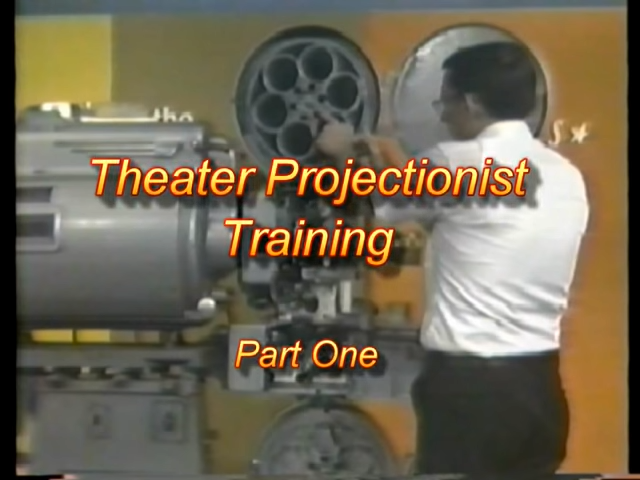
https://youtu.be/TDiUcLCv6hE
Can you spot the mistakes?
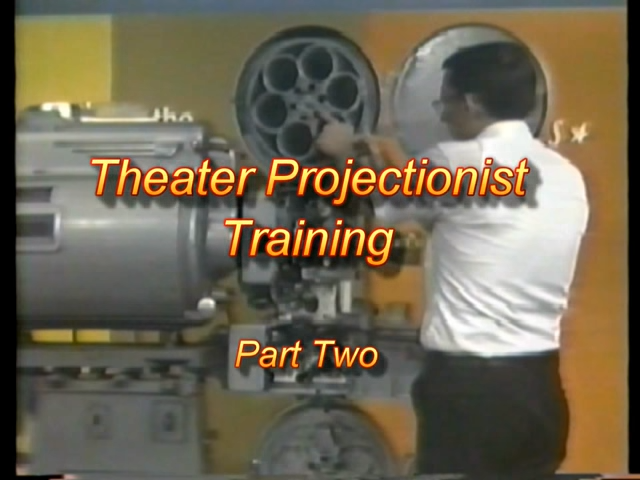
https://youtu.be/-8tH3qE53tU
Yes, I was guilty of overoiling
I learned the hard way. Note that in Part Two at 19:37, this instructional film gives the entirely wrong impression that there are only two image formats. Aaaarrrrgggghhhh!!!!
No cinema I know about had training even a twentieth as good as this superficial little educational video.
Zo, let us put that training to practical use:
For your spare-time reading:
“Planetary Projection,” Caboose, 2012.
Interesting memoirs from projectionists.
Oddly, I met or corresponded with a few of these folks.
Small world.
The editors seemed interested in publishing my memories, but they wanted short pieces devoid of anger, however righteous that anger may be.
Well, sorry, my story doesn’t lend itself to those restrictions.
Ahhhhhh, now this is how I wish films would be digitized, always!
The release versions can be tightened up just barely enough,
but the masters should all be done like this:
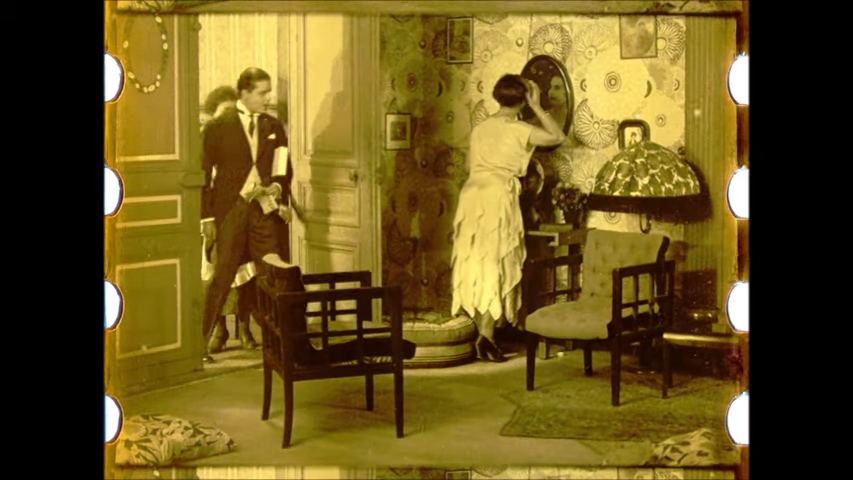
https://youtu.be/28-MfCddaAo
If a scan is done this way, then there is no doubt in anybody’s mind that the entire image was captured.
Message to all digitizers of film:
If the films have rounded corners or intentionally undersized camera apertures, so be it!
Do not zoom in to compensate!
Let the rounded corners and the black borders show!
Do not try to improve the image to satisfy “modern sensibilities”!
If the films originally had cue marks, do not paint out those cue marks!
In earlier films, do not delete the Part Titles!
In late silents and early talkies, in which nothing happens
during the several seconds on either side of the reel change,
or in which the beginning of the new reel duplicates the ending of the old reel,
keep all that material on the masters and issue it as supplements on the
For heaven’s sake: Just leave the films alone! DO NOT TRY TO MAKE THEM LOOK MODERN!
KONIEC
Text: Copyright © 2019–2022, Ranjit Sandhu.
Images: Various copyrights, but reproduction here should qualify as fair use.
If you own any of these images, please contact me.
Images: Various copyrights, but reproduction here should qualify as fair use.
If you own any of these images, please contact me.
